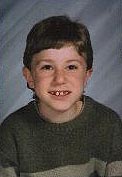Hello and Welcome to my page.

This is me at
Niagara Falls

These pages are
dedicated to my 9 year old son Jeremy

MEMBER
of the
POD
|

|
|
What is Duchenne
Muscular Dystrophy?
The muscular dystrophies are a group of muscle
diseases which have three features in common: they
are hereditary; they are progressive; and each
causes a characteristic, selective pattern of
weakness
.DMD affects only males, with rare exceptions.
Unless a boy with DMD is known to be at risk
because of his family history, he is unlikely to be
diagnosed before the age of 2 or 3 years. Most boys
with DMD walk alone at a later age than average.
Then the parents are likely to be worried about
something unusual in the way he walks, about
frequent falling or about difficulty rising from the
ground or difficulty going up steps. Less often,
concern arises because of intellectual handicap
("mental retardation"). Although intellectual
handicap affects only a minority of boys with DMD,
it is more frequent than in other children.
At this time there is no cure for DMD. The
worsening of disability can be slowed by such
measures as physiotheraphy, but it cannot be
stopped. On average, use of a wheelchair proceeds
from occasional use at about age 9 years to almost
total dependence by the early teens, but there is a
range of severity to either side of this.
As the ability to walk is lost, the function of the
hands and arms becomes increasingly important in
determining the affected person's abilities. Most
affected people survive into their twenties. A small
minority survive only to their late teens, another
small number to more than 30 years of age.

What is Autism?
Autism is a
developmental disability that typically
appears during the first three years of life. The
result of a neurological disorder that affects
functioning of the brain, autism and its
associated behaviors are reported to occur in as
many as one in five hundred individuals.
Autism is four times more prevalent in boys
than girls and knows no racial, ethnic or social
boundaries. Family income, lifestyle and
educational levels do not affect the chance of
autism's occurrence.
Autism interferes with the normal development
of the brain in the areas of reasoning, social
interaction and communication skills. Children
and adults with autism typically have
deficiencies in verbal and non-verbal
communication, social interactions and leisure
or play activities. The disorder makes it hard
for them to communicate with others and relate
to the outside world. They may exhibit repeated
body movements (hand flapping, rocking),
unusual responses to people or attachments to
objects and resist any changes in routines. In
some cases, aggressive and/or self-injurious
behavior may be present.
It is conservatively estimated that nearly
400,000 people in the U.S. today have some form
of autism. It's prevalence rate now places it as
the third most common developmental
disability - more common than Down's
syndrome. Yet the majority of the public,
including many professionals in the medical,
educational, and vocational fields are still
unaware of how autism affects people and how to
work effectively with individuals with autism.
 How Our Lives Were and Have Been Affected
Jeremy was born on May 8, 1991, at St. Clair Hospital in Pittsburgh, PA.
He was the picture of perfect health. Little did we know that when a routine sample of
blood was taken from him for the Supplemantal Newborn Screenings, that our lives would change 6 weeks
later.
We got a call 2 weeks after we had brought him home that Jeremy's CPK blood test had come back elevated.
We then took him for a second batch of bloodwork to prove or disprove the first results. On July 4th his doctor called
me and gave me the news that Jeremy's CPK had come back elevated again, and proceeded to tell me that my newborn son
had Muscular Dystrophy and we should meet with a geneticist in Pittsburgh.
On August 4th at Children's Hospital in Pittsburgh, Jeremy had a muscle biopsy done to determine
which type of MD he had. We got the results back and they confirmed Duchenne Muscular Dystrophy. From there my world did a
nosedive into a total dark abyss.
The first thing I thought, what is DMD? I had no clue. I did my research and came to the conclusion that my son
did not have this horrible, muscle robbing, genetic fatal disease. Denial is a wonderful thing for a while. Okay, so I got over that and
dug my heals into doing everything humanly possible to learn all I could about this DMD.
Well, just when you think that things are finally under control, you find that your sweet little boy is not keeping up with his
peers with talking, socialization, gross and fine motor skills, and his eye contact is non-existent. He lines blocks up on the floor and stares
at them for long periods of time. Withdraws into his own little world more and more. Right before his 4th birthday, we had him at the CDU
of Children's Hospital in Pittsburgh, PA. The doctors there told me that he was autistic. Okay, so what is autism? How in the world did
he get that? This time, there wasn't any denial. Just a rage that drove me to prove the so-called professionals wrong. See, they told
me that my son was severly autistic, would never talk, have a normal life, or be able to do anything. They had no answers to give
or any good advice.
So, I enrolled him in the Intermediate Unit 1's Child Alert Program. He spent 1 month there, headed off to a summer session,
and then spent the next full year with them again. I always thought that I would be sending my oldest son to school first. It is really hard
watching a van drive off with your 3 year old on it. As if to show everyone how wrong the world is, I enrolled Jeremy into the Autistic Support
Class in a public school near us. When he got to Kindergarten, he could use some language(mimicking of course), was potty trained,
could write when prompted, and was not aggressive in behaviour. So my credo "You can do and be anything you want" comes into effect.
My son is doing great. He is finishing his 3rd grade equavalent with an A average. That's right, an A. I give credit to
the wonderful teaching staff for being a dedicated and devoted part of my team. The hundreds of hours of time teaching my son behaviour
adjustments, All of the Physical Therapy, The Occupational Therapy, the Administrators for allowing my son the latitude to just sit
in the principal's office in the big round chair. The Secretarial Staff for hanging his classwork up and doing it with him. And to blow your
minds.....
Mrs. Rocco sent home an article that appeared in February's issue of Parents Magazine. This article was written by Karyn
Seroussi and she cured her son of Autism. Now, her son was not quite 2 when she discovered what could be used to cure
him. Jeremy was almost 9 when I read this. And regardless of the age difference, I had to give it a try. I know I can't cure the
DMD, so I am going to give everything I have to cure the Autism.
Food Intervention. It all boils down to removing foods from the children's diet to alleviate symptoms of this monster.
Please, for more information regarding this possible cure, visit GFCF DIET. We have had Jeremy on this
diet for almost 3 months and I know that it is going to take time, but the changes in him are extraordinary. He has better concentration,
his verbalization is soaring, his speech is clearer, his attention span is increasing, and he is more aware of social situations.
How Our Lives Were and Have Been Affected
Jeremy was born on May 8, 1991, at St. Clair Hospital in Pittsburgh, PA.
He was the picture of perfect health. Little did we know that when a routine sample of
blood was taken from him for the Supplemantal Newborn Screenings, that our lives would change 6 weeks
later.
We got a call 2 weeks after we had brought him home that Jeremy's CPK blood test had come back elevated.
We then took him for a second batch of bloodwork to prove or disprove the first results. On July 4th his doctor called
me and gave me the news that Jeremy's CPK had come back elevated again, and proceeded to tell me that my newborn son
had Muscular Dystrophy and we should meet with a geneticist in Pittsburgh.
On August 4th at Children's Hospital in Pittsburgh, Jeremy had a muscle biopsy done to determine
which type of MD he had. We got the results back and they confirmed Duchenne Muscular Dystrophy. From there my world did a
nosedive into a total dark abyss.
The first thing I thought, what is DMD? I had no clue. I did my research and came to the conclusion that my son
did not have this horrible, muscle robbing, genetic fatal disease. Denial is a wonderful thing for a while. Okay, so I got over that and
dug my heals into doing everything humanly possible to learn all I could about this DMD.
Well, just when you think that things are finally under control, you find that your sweet little boy is not keeping up with his
peers with talking, socialization, gross and fine motor skills, and his eye contact is non-existent. He lines blocks up on the floor and stares
at them for long periods of time. Withdraws into his own little world more and more. Right before his 4th birthday, we had him at the CDU
of Children's Hospital in Pittsburgh, PA. The doctors there told me that he was autistic. Okay, so what is autism? How in the world did
he get that? This time, there wasn't any denial. Just a rage that drove me to prove the so-called professionals wrong. See, they told
me that my son was severly autistic, would never talk, have a normal life, or be able to do anything. They had no answers to give
or any good advice.
So, I enrolled him in the Intermediate Unit 1's Child Alert Program. He spent 1 month there, headed off to a summer session,
and then spent the next full year with them again. I always thought that I would be sending my oldest son to school first. It is really hard
watching a van drive off with your 3 year old on it. As if to show everyone how wrong the world is, I enrolled Jeremy into the Autistic Support
Class in a public school near us. When he got to Kindergarten, he could use some language(mimicking of course), was potty trained,
could write when prompted, and was not aggressive in behaviour. So my credo "You can do and be anything you want" comes into effect.
My son is doing great. He is finishing his 3rd grade equavalent with an A average. That's right, an A. I give credit to
the wonderful teaching staff for being a dedicated and devoted part of my team. The hundreds of hours of time teaching my son behaviour
adjustments, All of the Physical Therapy, The Occupational Therapy, the Administrators for allowing my son the latitude to just sit
in the principal's office in the big round chair. The Secretarial Staff for hanging his classwork up and doing it with him. And to blow your
minds.....
Mrs. Rocco sent home an article that appeared in February's issue of Parents Magazine. This article was written by Karyn
Seroussi and she cured her son of Autism. Now, her son was not quite 2 when she discovered what could be used to cure
him. Jeremy was almost 9 when I read this. And regardless of the age difference, I had to give it a try. I know I can't cure the
DMD, so I am going to give everything I have to cure the Autism.
Food Intervention. It all boils down to removing foods from the children's diet to alleviate symptoms of this monster.
Please, for more information regarding this possible cure, visit GFCF DIET. We have had Jeremy on this
diet for almost 3 months and I know that it is going to take time, but the changes in him are extraordinary. He has better concentration,
his verbalization is soaring, his speech is clearer, his attention span is increasing, and he is more aware of social situations.
More of the story to
come soon!

DMD-AUTISM-FRIENDS
related links
Jeremy's June 4, 1998 Newspaper
article
Thank You To Everyone For Your Donations!

 It Really Is Okay To Talk About It
It Really Is Okay To Talk About It

 Sign My Guestbook
Sign My Guestbook
 View My Guestbook
View My Guestbook









LE FastCounter